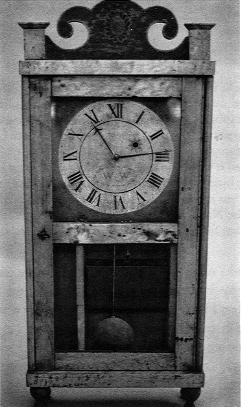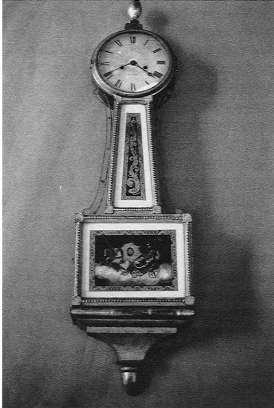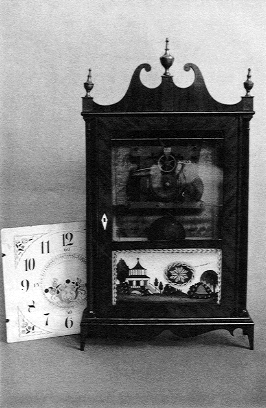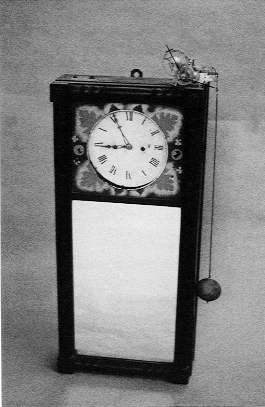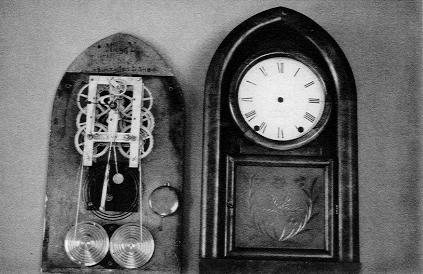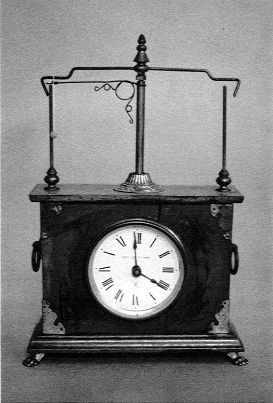Dartmouth College Library Bulletin
ALLEN L. KING
A selection of clocks from the Dr. Hugh Grant Rowell Collection, along with books, letters, and other horological materials, was exhibited in the corridor windows of Baker Library from 1 May to 2I June 1992. Because Dr. Rowell, who assembled the collection, was a I9I5 graduate of Dartmouth College, his former associate and business partner Mrs. Alice M. Runyon of North Tarrytown, New York, donated it to the College in his memory.It now serves as a resource for research in the history of American clockmaking during the nineteenth century. The exhibit was mounted in time for the visit on 2 May of the New England Section of the National Association of Watch and Clock Collectors and it remained in place for Dartmouth's commencement activities through midJune.
ON the banks of the Hudson near the Tappan Zee and not far from Sleepy Hollow, where Irving's Ichabod Crane encountered the Headless Horseman, 'lies a small market town or rural port, which by some is called Greensburgh but which is more generally and properly known by the name of Tarry Town.'1 Here in later days lived a doctor with many interests: health educator, author, restorer of historic structures, student of patriotic lineage, collector of circusiana and antique clocks. By 1934 Dr. Hugh Grant Rowell already had more than fifty clocks in his collection, 'no two of which tell exactly the same time,' thus giving him 'his needed excuse to the class when he misses his train to town,' as reported in the Dartmouth Alumni Magazine of that year.2 Over the years the collection grew until at his death in 1963 it contained 165 clocks, more or less. Dr. Hugh, as he was affectionately called, had assembled a curious and wonderfully varied assortment of antique clocks, several foreign but mostly American, that were scattered from attic to basement throughout his house.
Dr. and Mrs. Rowell were especially fond of Dutch and English clocks, as illustrated by their first five acquisitions. Later, they added a few more and a number of clocks from other countries as well. But, beginning with the sixth clock, a Primitive American handmade late eighteenth- or early- nineteenth-century shelf clock (Fig. 1), Dr. Rowell made a special effort to acquire representative examples, primarily shelf and wall clocks, by American clockmakers and manufacturers including such notables as Simon and Aaron Willard, Eli and Silas B. Terry, Joseph Ives, Chauncey Boardman, Mark Leavenworth, Silas Hoadley, Seth Thomas, Chauncey Jerome, Elias Ingraham, Aaron Crane, J. C. Brown, and many, many others. The collection is important especially for historical research. It illustrates the development of a fascinating decorative art form and industry from individually handcrafted clocks at the end of the eighteenth century, through the beginnings of mass production of interchangeable parts, to largescale manufacturing during the latter half of the nineteenth century.
In colonial times in the provinces, there were very few clockmakers, and these generally produced tall case clocks. However, the burghers of New Amsterdam and up the Hudson Valley imported Dutch clocks in goodly numbers. Similarly, other colonists who could afford them imported clocks primarily from England, France, and Germany. Foreign-made clocks were expensive: but the immigrant and indigenous clockmakers in the colonies could not make them for less money because suitable brass and steel from abroad and the necessary handwork were costly. With the advent of the Revolutionary War and subsequent problems with Great Britain on the high seas, imports were curtailed and for the next sixty years brass and spring steel were scarce and expensive. There was need for a small inexpensive clock that could be purchased by the less affluent citizens of the new democracy. Simon Willard of Grafton, Massachusetts, recognized this need and before the end of the century invented his 'Improved Patent Timepiece' or Banjo Clock, for which he received a patent in 1802. Figure 2 shows a clock with modifications to Willard's design.
Because of the scarcity of brass the amount used in a clock often was reduced to a minimum by clever design of the movement, as in Emerson's New Hampshire mirror clock (Fig. 3), or by replacing it where possible with iron, as in many Ives's clocks. But native wood of good quality was plentiful and cheap. Therefore, other clockmakers resorted to wood for their movements. Eli Terry, like many other clockmakers of the time, with the help of apprentices made and sold handmade movements, pendulums, dials, hands, and weights in sets for tall case clocks. Tall case mechanisms, however, were large and cumbersome; cases by local craftsmen often were too expensive; and the whole procedure was too slow to meet the potential demand.
By I8O2 Eli Terry had begun manufacturing clocks with water power for the wholesale trade, a new venture in the clock industry. Even so, much handwork still had to be done. Five years later Terry contracted to produce for the Porter brothers, two Connecticut entrepreneurs, 4000 tall case wooden movements, dials, and hands at $4 per set within three years. During the first year he developed machinery and methods for manufacturing and assembling interchangeable parts so as to reduce skilled hand labor. Then, with the help of joiners Seth Thomas and, later, Silas Hoadley, he succeeded in completing the task within the allotted time.3 With that done he sold his shop to his two young assistants. The year was 181O.
During the next few years Terry designed and improved an attractive encased small shelf clock with wooden movement having both time and strike wheelwork, powered by weights falling through only eighteen inches, and controlled by a short pendulum. The clock was wholly self-contained, portable, and inexpensive. Although he began marketing it in 1814 he did not receive a patent for it until 1816. Terry continued to refine this clock until he produced the standard pillar and scroll model, which became very popular during the third decade of the nineteenth century.4.
In 1814 Seth Thomas obtained a license from Terry to manufacture this patented clock (Fig. 4). But several other clockmakers circumvented the patent by designing their own movements, represented in the collection by Silas Hoadley's upside-down movement, Norris North's Torrington movement, and Chauncey Boardman's overhead-strike movement. Many clockmakers, however, simply purchased movements from Terry or Thomas to encase and sell under their own labels. Cases were made in a great variety of styles, incorporating mirrors, stenciling, carved columns and splats, or other embellishments all amply illustrated by clocks in the Rowell collection.
With the founding of the American brass industry in the 1830's brass became more plentiful and suffficiently inexpensive to compete favorably with wood, especially in the more convenient eight-day shelf clocks. But with the onset of the great depression of 1837, the clock industry faltered. Fortunately, at this critical time Chauncey Jerome and his brother Noble introduced a cheap clock with a thirtyhour brass movement in a case of simple design. It soon drove wood movements offthe market and made possible a lucrative trade abroad.5.
In 1836 Joseph Shaylor Ives, nephew of Joseph Ives, was granted a patent for making coiled springs from brass. With fusees, they were reliable steady sources of energy. The earliest application was made by Brewster and Ingraham in their rounded Gothic or beehive clock6. as represented in the collection by the specimen that James Cropsey purchased in 1836 (Fig. 5). Within a few years brass springs were replaced by springs of steel, fusees were eliminated, and clocks that kept reasonably accurate time could be made much smaller in size. The moment had come for rapid expansion in factory production. The Rowell collection is well supplied with examples of factorymade clocks. Among them Clausen's flying pendulum clock,7. the 'jester of the collection,' intrigued and amused Dr. Rowell very much. He dubbed it Ignatz, as it is known today (Fig. 6).
Dr. Rowell published numerous articles, often illustrated, about American clocks and clockmakers from his collection. He kept up an extensive correspondence with other collectors and served as a resource person for the inquiring layman. Dr. Rowell made Tarrytown more than a marketplace; he established it as a center for clock lore.
Hugh Grant Rowell was born one hundred years ago on 3 November at Barton Landing (renamed Orleans), Vermont. There he attended public schools before entering Phillips Exeter Academy, from which he graduated in 1911, and then Dartmouth College where he received his AB degree in 1915. He continued his medical training at Harvard for his MD in 1917 but postponed further studies by serving as a private in the Medical Enlisted Reserve Corps during World War I.
After his wartime service he returned to postgraduate work at the Massachusetts General Hospital. Here he met graduate student Sara Miller Dennis of Halifax, Nova Scotia, whom he married on 2I September 1921. At about this time Dr. Rowell began his teaching career with an appointment in the School Department of Bedford, Massachusetts; but by 1923 he had joined the faculty at Columbia University where he remained until his retirement in 1943. He and Sara resided in North Tarrytown, New York, summered in Orleans, Vermont, and frequently visited Halifax, Nova Scotia.
Dr. Rowell developed many interests. He wrote extensively on health and education matters and on his several hobbies. He was an ardent fan of the circus and made a collection of circusiana. His niece reported that he had a close friendship with clowns and other circus personnel, who enjoyed his visits whenever they were in town. Meanwhile he became an enthusiastic connoisseur of antique clocks. Beginning in 1931 and until his retirement from Columbia he assembled a truly remarkable collection of them.
On his retirement in 1943 Dr. Rowell concentrated on still another interest of his: local history and the restoration of Philipse Castle in North Tarrytown. His work attracted the attention of John D. Rockefeller Jr. who joined him and his associate and business partner Mrs. Alice M. Runyon in establishing Sleepy Hollow Restorations, Inc., for which Dr. Rowell served as full-time director from 1943 to 1955. Later they restored Sunnyside in Tarrytown, the home of Washington Irving, overlooking the Hudson River.
Perhaps because of his own long-time affliction Dr. Rowell became a consultant and board member of the New York League for the Hard of Hearing and wrote books and several articles on the subject. Also, he acquired an extensive knowledge of genealogy and heraldry, became an active member and officer of numerous genealogical and heraldic societies, and served as a consultant in these fields. Dr. Rowell was a truly versatile man!
Fig. I. Primitive Shelf Clock (RC No. 6), the first American-made clock acquired by Dr. Rowell. It has hammered iron plates with brass bushings, hands forged from iron rod, a dial painted on a square sheet of hammered iron, and veneer of burled maple. It is signed W-W; maker W-W and date of manufacture are unknown.
Fig. 2. Banjo Wall Clock (RC No. 11) was made by Reuben Tower of Hingham, Massachusetts, circa I8I5. This clock illustrates mod)fications to Simon Willard s original 'Improved Patent Timepiece' such as the bracket at the bottom, the back-painted mythological figure of Apollo riding in his chariot on the lower glass, and the added rack-and-snail strike mechanism. Rowell wrote of it: 'The workmanship throughout is superb and, in my opinion, far superior to the Willards.'
Fig. 3. New Hampshire Mirror Clock (No. 108) by William G. Emerson of Newport, Maine, with Morrill's unique S-shaped brass movement from RC No. Io perched on top. Whereas Benjamin Morrill of Boscawen, New Hampshire, used this unique movement in his mirror clocks, Emerson employed Willard-Benjamin Morrill of Boscawen, New Hampshire, used this unique movement on his mirror clocks, Emerson employed Willard-style movements. Fig. 4. Pillar and Scroll Shelf Clock (RC II8) as designed by Eli Terry, circa 1816 to 1817, and made by Seth Thomas, both of Plymouth, Connecticut. The dial has been removed to show the wooden clockwork. Fig. 5. Fusee Beehive Clock (RC No. 81), signed E.C. Brewster, Bristol, Connecticut. It was purchased in 1836 by haberdasher James Cropsey for his newly opened store at 63 Meadow Lane in New York City. Straightway he wrote on its backboard the date, his name and address, and signed the bob as well. Brass springs and inverted fusees were first used by Brewster in Elias Ingraham's beehive case. Fig. 6. Flying Pendulum Clock (RC No. 60), Rowell's original Ignatz, in his words, the 'craziest clock in the world.' Its inventor, Adler Christian Clausen of Minneapolis, Minnesota, patented it on 23 August 1883.1.From Washington Irving's 'The Legend of Sleepy Hollow.'
2.Class of 1915 notes by Secretary Harold K. Davison, Dartmouth Alumni Magazine, 26, no. 7 (April 1934), 57.
3.Lockwood Barr, 'Eli Terry Pillar & Scroll Shelf Clocks,' Supplement to the 1952 Bulletin of the National Association of Watch and Clock Collectors, Inc.
4.Snowden Taylor, The Development Era of Eli Terry and Seth Thomas Clocks (Fitzwilliam, N.H.: Ken Roberts Publishing Co., 1985).
53.Chris H. Bailey, Two Hundred Years of American Clocks & Watches (Englewood Cliffs, N.J.: Prentice-Hall,Inc., 1975), pp. 148-149.
6. Allen L. King, 'The Key,' Bulletin of the National Association of Watch and Clock Collectors, Inc., 23 (I98I): 598-599.
7. Hugh G. Rowell, 'Ye Great American Gadget Clock,' American Collector 4, no. 5 (22 August 1935), 6-7.
